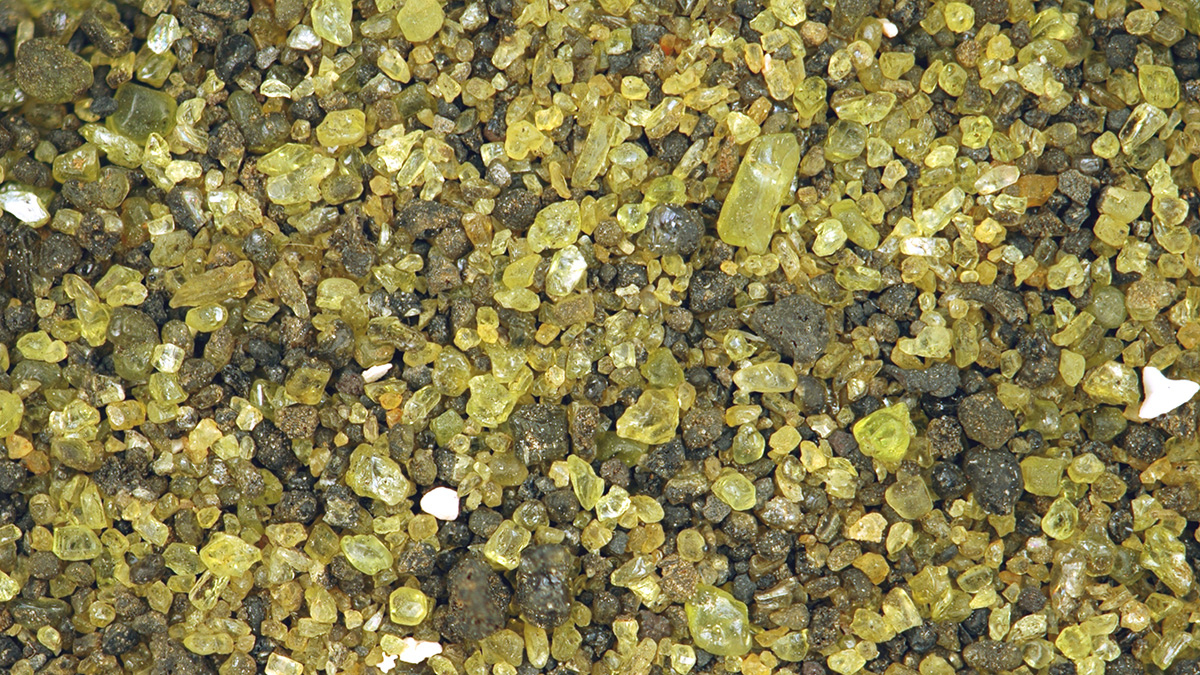The world’s oceans play a key role in sucking up carbon from the atmosphere. Until anthropogenic carbon emissions began on a mass scale with the Industrial Revolution, ocean carbon uptake was one part of a land-ocean-atmosphere juggling act that kept the carbon cycle roughly in balance.
Now, a California-based company wants to use green sand to exploit the carbon sponge of the ocean to avoid the worst outcomes of global warming.
The Need for Speed
Vesta is a private company that believes it can speed up the ocean’s long-term carbon sequestration process by treating coastal areas with crushed olivine. Although high-quality olivine can be used as a gemstone (peridot), it is a relatively inexpensive mineral whose properties (it weathers very quickly) have long been studied as a means of enhanced weathering or ocean alkalinization, which some scientists have proposed as a way to mitigate climate change.
In the natural process of weathering, rocks are broken down by phenomena such as rain and extreme temperatures. Rain absorbs carbon dioxide (CO2) from the atmosphere and forms bicarbonate ions when it reacts with rocks rich in silicate and magnesium, like olivine. The bicarbonate flows into the ocean, where it is ingested by marine organisms to create shells and exoskeletons; these shells as well as precipitates of the weathered minerals themselves can form limestone and other carbonates that store carbon for thousands of years. The bicarbonate also acts as a kind of antacid in the ocean, helping to fight ocean acidification.
In what Vesta describes as coastal carbon capture, the weathering process is accelerated by grinding large amounts of olivine into beach and seafloor sand, increasing the surface area of the mineral available for chemical reaction with seawater.
The idea isn’t new, and the environmental side effects are ambiguous. The operation would expend energy and, potentially, carbon emissions. Vesta has also partnered with the largest dredging company in the United States, raising questions about environmental impact to pelagic communities around the seafloor.
“While the idea of accelerating the Earth’s natural geological carbon removal process was proposed in 1990 and various papers had been published, there was no progress towards field trials,” said Tom Green, CEO and cofounder of Vesta. “Various scientists have called for field trials, including in late 2021 the National Academies of Sciences, Engineering, and Medicine in their report on ocean carbon dioxide removal [CDR].”
Will It Scale?
Whether coastal carbon capture could put a sizable dent in the nearly 32 billion metric tons of CO2 that society is pumping into the atmosphere annually remains unclear. Vesta said it is developing techniques that would remove at least a gigaton of atmospheric CO2 per year.
In addition to environmental concerns, another key question is whether coastal carbon capture is financially practical.
“Our analysis indicates that on a large scale, coastal carbon capture could remove CO2 for $35 per ton, which is cheaper than other permanent forms of CO2 removal,” said Green. “At the moment, it is much more expensive since we are operating at small scales and optimizing for rigorous scientific study rather than cost.”
There are also questions about the science. Earlier this year, a Frontiers in Climate study of olivine weathering in simulated seawater found that “CO2 uptake is reduced by a factor of 5 due to secondary mineral formation and the buffering capacity of seawater. In comparable natural settings, olivine addition may thus be a less efficient CDR method than previously believed.”
In a blog post responding to the paper, Vesta said the lab-based study had “limited applicability to field settings and it would not be prudent to draw significant conclusions about the feasibility of Coastal Carbon Capture from it.” The company also said that studies like a 2017 paper in Environmental Science and Technology confirm the basic viability of its approach.
“The biggest barrier is likely to be the massive scale of our carbon dioxide emissions.”
“I like olivine as a CO2 sink, but I think one has to grab the CO2 from the air before the alkalinity reaches the ocean,” said David Archer, a geophysics professor at the University of Chicago who is not involved with Vesta. Archer pointed to an Environmental Research Letters paper analyzing ocean alkalinization along the Great Barrier Reef. “Everyone assumes that if you add base to the ocean, it will pull CO2 from the atmosphere, but this will take thousands of years.”
“We know that nature neutralizes carbon dioxide through a process based on the weathering of silicate rocks. It seems highly likely that humans could accelerate this process,” said Ken Caldeira, a senior scientist emeritus at the Carnegie Institution for Science’s Department of Global Ecology who has done experiments adding alkalinity to seawater; he is not involved with Vesta. His main question is not whether the approach would work but whether its economic and environmental costs are worthwhile given the massive scale needed to make an impact.
“Maybe mineral weathering and alkalinity addition to the ocean can play a useful role. But we won’t know if it can play a useful role unless we try,” said Caldeira. “We should expect some bumps in the road. But the biggest barrier is likely to be the massive scale of our carbon dioxide emissions.”
With millions of dollars from crowdfunding, grants, and corporate investments, Vesta is pushing ahead with field tests. It recently launched a pilot project in New York and has plans for further trials in the Dominican Republic as well as elsewhere in the United States.
—Tim Hornyak (@robotopia), Science Writer

